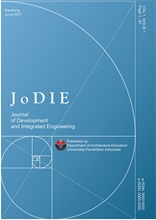IMPLEMENTATION OF HOSPITAL INPATIENT ROOM DESIGN THAT SUPPORTS THE HEALING PROCESS
Abstract
Hospitals as health facilities need to be supported in all aspects. The healing factors obtained from health services do not stand alone but must be supported by physical health facilities to make the healing process more comprehensive. Many rules must be applied in hospitals and many aspects must be taken into account when designing a hospital, so designers must understand how to design according to standard rules and also aspects of user needs because healing is carried out through the physical and psychological aspects of the patient to encourage a more effective healing process. With the various facilities in hospitals, the role of inpatient rooms is often not a priority compared to service-based health facilities such as the emergency room, operating room, ICU room, and hemodialysis room which are important priorities. Even though the healing process takes the longest time in the inpatient room. It is felt that the current arrangement of inpatient rooms does not support the healing process. Therefore, this paper aims to guide designing inpatient rooms that truly meet the behavioral needs of residents so that it is hoped to create an inpatient room that encourages healing (healing environment). The method applied is descriptive qualitative by studying it based on the theory of architectural behavior & architectural psychology, namely a Healing Environment that is suitable for hospitals through analysis of behavior that produces a need for space elements. Observe the condition of the inpatient room and the expected behavior of the occupants. The results of the analysis of inpatient rooms will be in the form of guidelines for designing inpatient rooms comprehensively. How to choose colors, choose finishing materials, furniture, and other necessary elements. The author hopes that this article can be used by all parties who will design, renovate, or carry out further research regarding inpatient room design. For designers, hospital owners, and hospital management throughout Indonesia, so whatever hospital class, location, government-owned, private, or foundation can apply hospital room design well.
keywords: inpatient room, Healing Environment, Interior Design
Full Text:
PDFReferences
Alhamdani, M. R., & Sari, D. P. (2019). Performance Evaluation of Pontianak Kapuas Indah Market from Architecture and Behaviour Aspect. Journal of Architectural Research and Education, 1(2), 107. https://doi.org/10.17509/jare.v1i2.22301
Arofah, W. R., Permana, A. Y., & Mardiana, R. (2019). Implementation of Responsive Architectural Concepts in the Design of the Cikole Forest Resort, Bandung, West Java. Indonesian Journal of Built Environmental and Sustainability, 1(1), 1. https://doi.org/10.31848/ijobes.v1i1.247
Bawono, A. (2019). Creative economic development of Islamic boarding schools. Shirkah: Journal of Economics and Business, 3(1), 25-47.
Ceylan, C., Dul, J., and Aytac, S. (2008). Can the office environment stimulate a manager's creativity?. Human Factors and ergonomics in Manufacturing and service Industries, 18(6), 589-602.
Ghasempourabadi, M., & Hassanzadeh, H. (2021). COVID-19 DISSEMINATION ASSESSMENT THROUGH NATURAL VENTILATION IN HOSPITAL PATIENT ROOM. Journal of Architectural Research and Education, 3(1), 1–13. https://doi.org/10.17509/jare.v3i1.31309
Ghassani, A. I., Permana, A. Y., & Susanti, I. (2019). Konsep Ekowisata Dalam Perancangan Resort di Kabupaten Ciamis. Jurnal Arsitektur TERRACOTTA, I(1), 11–21.
Kencanasari, R. . V., Surahman, U., Permana, A. Y., & Nugraha, H. D. (2020). Enhancing Community Environmental Awareness Through Indoor Air Quality Workshop. Journal of Architectural Research and Education, 2(2), 165–175. https://doi.org/10.17509/jare.v2i2.30290
Maulana, R. (2015). The influence of human capital on regional economic growth in Central Java province. Economics Development Analysis Journal, 4(2), 159-165.
McCoy, J. M., and Evans, G. W. (2002). The potential role of the physical environment in fostering creativity. Creativity Research Journal, 14(3-4), 409-426.
Nurahman, H., Purwatiana, R. A., Kusliansjah, Y. K., & Permana, A. Y. (2023). Revitalization of Colonial Buildings as Community Centre: Case Study of the Former Radio Cililin Building, Bandung, West Java, Indonesia. Journal of Design and Built Environment, 23(2), 34–56. https://doi.org/10.22452/jdbe.vol23no2.3
Nurrahman, H., Permana, A. Y., & Akbardin, J. (2022). A virtual tourism model as an alternative to the concept of post Covid-19 educational tourism in Bandung. AIP Conference Proceedings, 050002(December).
Permana, A. Y., Akbardin, J., Permana, A. F. S., & Nurrahman, H. (2020). The concept of optimal workplace in providing a great experience to improve work professionalism in the interior design of PLN Corporate university, Ragunan, Jakarta. International Journal of Advanced Science and Technology, 29(7), 3238–3254. http://sersc.org/journals/index.php/IJAST/article/view/18953
Permana, A. Y., Mardiana, R., Dewi, N. I. K., Sumanta, R. V. V., Ezzaty, F. M., & Nareswari, P. A. (2022). Evaluation of Classroom Performance in The Post-Covid- 19 New Normal Era at The Building Program Vocational High School. Journal of Southwest Jiaotong University, 15(2), 126–145.
Permana, A. Y., Nurrahman, H., & Permana, A. F. S. (2021). Systematic assessment with “poe” method in office buildings cases study on the redesign results of office interior after occupied and operated. Journal of Applied Engineering Science, 19(2), 448–465. https://doi.org/10.5937/jaes0-28072
Permana, C. S., Permana, A. Y., & Dewi, N. I. K. (2020). Penerapan Konsep Green Architecture dalam Perancangan Hotel Resort di Kabupaten Tasikmalaya. UNDAGI: Jurnal Ilmiah Arsitektur Universitas Warmadewa, 8(2), 82–94.
Setiawan, A., Akbardin, J., & Maknun, J. (2021). Analysis of Demand Potential and Need for Passenger Terminal Facilities at Cikembar Sukabumi Airport. Journal of Architectural Research and Education, 3(1), 67–81. https://doi.org/10.17509/jare.v3i1.3293
Shapirov, I. (2015). Contemporary economic growth models and theories: A literature review. CES Working Papers, 7(3), 759-773.
Shibata, S., and Suzuki, N. (2004). Effects of an indoor plant on creative task performance and mood. Scandinavian Journal of Psychology, 45(5), 373-381.
DOI: https://doi.org/10.17509/jodie.v3i2.67947
Refbacks
- There are currently no refbacks.
Copyright (c) 2024 Rosdiana Wulandari, Asep Yudi Permana

This work is licensed under a Creative Commons Attribution-NonCommercial-ShareAlike 4.0 International License.

This work is licensed under a Creative Commons Attribution-ShareAlike 4.0 International License.








